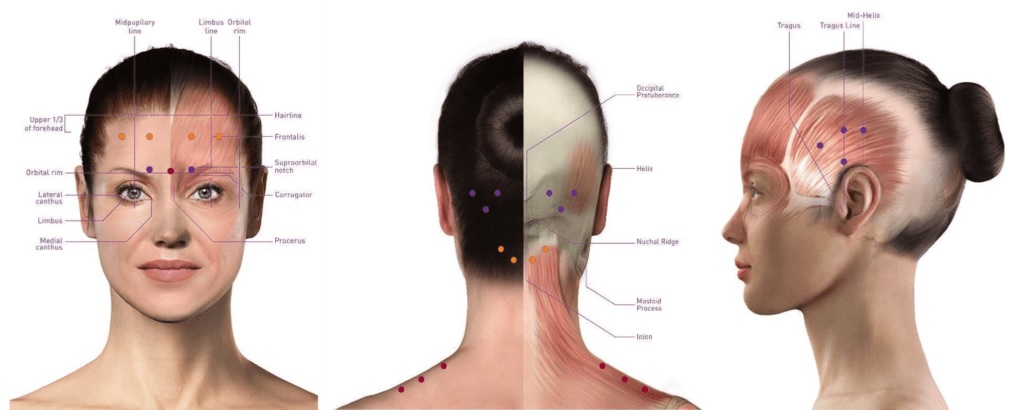BOTULINUM TOXIN TREATMENT
Botulinum toxin or Neurotoxin treatment has been frequently mentioned in neurology practice in recent years, especially in migraine treatment.
Botulinum Neurotoxin (BoNT) is actually a very powerful poison produced from a bacterium. What makes this poison a medicine is knowing the dose and the fact that the practitioner is a physician.
BoNT, which has been used for many years and was first used in the treatment of strabismus and blepharospasm, was last approved by the US Food and Drug Administration (FDA) for migraine treatment after the PREEMPT study published in 2010. The PREEMPT study showed that BoNT reduces the frequency and severity of migraine pain, reduces the rate of painkiller use, and increases the quality of life. Therefore, it has been supported that it is also effective in medication overuse headaches.
Who can BoNT be applied to in migraine?
The indication is for CHRONIC MIGRAINE patients diagnosed by a neurologist. The criteria here are quite clear;
It is applied to patients who experience migraine pain 15 or more days a month,
Those who have used other migraine prophylaxis medications,
Over the age of 16, and are not pregnant.
How and by whom is it done?
The procedure is performed on standardized forehead, temple, neck, nape and shoulder points with specially manufactured injectors. The procedure should be performed on at least 31 points and a total of 155 Units. In some resistant cases, additional trigger points can also be applied. The maximum application dose is determined as 195 Units.
The procedure should be performed by a NEUROLOGY specialist. The procedure is completed in approximately 10-20 minutes, excluding the preparation process.
Is there any pain during the procedure?
Since very fine-tipped injectors are used for the procedure and some applications can be made before the procedure to reduce the feeling of pain, there is no significant problem other than a slight feeling of pain.
Where should the procedure be performed?
It should not be performed outside a health institution/clinical environment. In order to ensure hygiene and asepsis rules during the procedure and to monitor any problems that may arise related to the procedure, the procedure should be performed under the supervision of a NEUROLOGY specialist with experience. BoNT application in migraine is part of a holistic approach to migraine treatment and is a medical treatment. It is not a cosmetic application. It should be performed by neurologists who are technically appropriate, can monitor pain, and are specialized in this field.
What is the frequency of application?
The application is repeated 3 months after the first application and then every 6 months for at least 2 years. In order to evaluate the success of the application, it must be done at least twice. It cannot be said that this treatment is not beneficial without at least two applications.
What are the expected effects?
The main goals are to reduce the frequency of migraine attacks, shorten their duration and alleviate their severity. However, a decrease in excessive painkiller use is also expected. As a result of all this, there is an increase in the quality of life due to migraine, which is one of the most important workforce losses under the age of 50.
Does it have any side effects?
It has very few side effects and is easily tolerated. BoNT is a reliable treatment for migraine. The important point is to perform the procedure with the right technique and at appropriate doses. Despite all this, temporary neck pain, sometimes headache, weakness in the neck muscles, drooping eyelids, pain and redness at the injection sites may occur. These side effects are temporary and rarely seen.
How does botulinum neurotoxin relieve migraine pain?
BoNT, in cases of dystonia, spasticity, hemifacial spasm or blepharospasm, which can be summarized as excessive and involuntary muscle contractions seen in neurology practice, causes a soft and temporary paralysis in the muscles and temporarily prevents muscle contraction. This effect lasts for an average of 6 months.
In migraine attacks, the mechanism of action is different. The applied BoNT technically affects the nerve ending points located in the forehead, temples, nape and neck. BoNT applied to these points enters the nerve endings and suppresses the release and production of certain neurochemical substances (CGRP, Substance P etc.) that carry the sensation of pain to the pain centers of the brain. BoNT, which also affects the pain receptors (receptors) located in these nerves and that have become easily sensitive to stimulation by certain migraine triggers, helps to eliminate attacks related to triggers by preventing this sensitization (desensitization).
How long does botulinum toxin treatment last? Is it lifelong?
BoNT, in neurological diseases that cause excessive and involuntary muscle contractions such as dystonia, spasticity, hemifacial spasm or blepharospasm, its effect of preventing muscle contraction lasts for an average of 6 months. At the end of this period, it may be necessary to apply it again depending on the condition of the complaints.
In migraine, the mechanism of the neurotoxin is different, it affects the nerve cells in the brain regions that cause migraine, reduces the release of neurochemicals that cause pain production and especially the desensitization effect on the pain receptors in the nerve endings, leading to pain control. The general acceptance in migraine is to continue the treatment for up to 2 years with applications repeated 3 months after the first application and every 6 months. However, after 2 years, it may be necessary to repeat the application at certain intervals depending on the clinical condition of the patient and the neurologist who monitors the patient.




Cevapla
Want to join the discussion?Feel free to contribute!